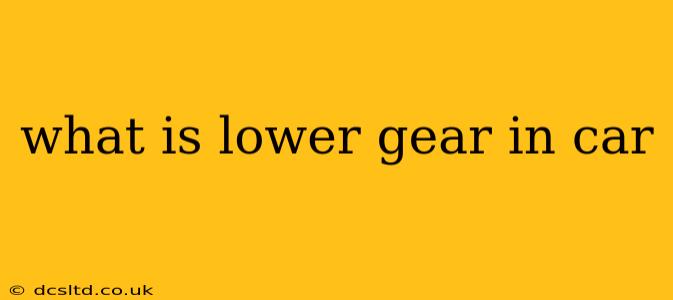Lower gears in a car refer to the lower numerical gear ratios within your vehicle's transmission. This means that for each rotation of the engine's crankshaft, the wheels will rotate fewer times. While it might seem counterintuitive, using a lower gear provides significant advantages in specific driving situations. This comprehensive guide will explain what lower gears are, when to use them, and why they're crucial for optimal vehicle performance and safety.
What are Gear Ratios and How Do They Work?
Before diving into lower gears, understanding gear ratios is key. A gear ratio is simply the relationship between the number of rotations of the engine and the number of rotations of the driven wheels. A lower gear ratio means the engine spins more times for every wheel rotation, providing more torque. A higher gear ratio means the engine spins fewer times for every wheel rotation, resulting in higher speed but less torque.
Think of it like a bicycle: A low gear (easier to pedal) is like a lower gear in a car—it's great for uphill climbs or starting from a standstill. A high gear (harder to pedal but faster) is analogous to a higher gear in a car—ideal for maintaining speed on flat roads.
When Should You Use Lower Gears?
Lower gears are essential in several scenarios:
Starting and Accelerating:
This is perhaps the most common use. When starting from a standstill or accelerating quickly, you need plenty of torque to overcome inertia. Lower gears provide this extra power, enabling smoother starts and quicker acceleration.
Climbing Hills and Inclines:
Hills present significant resistance. Lower gears compensate for this by increasing engine torque, ensuring your car can maintain momentum and prevent stalling or struggling.
Towing or Hauling Heavy Loads:
Similar to hill climbing, towing or hauling requires considerable power. Using lower gears provides the extra torque needed to safely and effectively move heavier loads.
Driving in Difficult Conditions:
Snow, ice, mud, or sand significantly reduce traction. Lower gears provide the necessary torque to maintain control and prevent wheelspin in these challenging conditions.
What Happens if You Don't Use Lower Gears Appropriately?
Using inappropriately high gears in situations requiring more torque can lead to several problems:
- Stalling: The engine may struggle and stall, especially when starting or climbing steep hills.
- Reduced Acceleration: Acceleration will be sluggish and slow, potentially putting you at risk in traffic.
- Engine Overstrain: The engine might have to work excessively hard, leading to increased wear and tear.
- Loss of Control: In slippery conditions, using a higher gear can cause wheelspin and loss of control.
How Many Lower Gears Does a Car Have?
The number of lower gears varies depending on the vehicle's transmission type (manual, automatic, CVT). Manual transmissions typically have multiple lower gears (1st, 2nd, sometimes 3rd), while automatics use a combination of gears and torque converters to achieve similar results. CVT transmissions offer a continuously variable range, effectively eliminating distinct gear ratios but still providing equivalent torque in low-speed situations.
What is the Difference Between Low Gear and Reverse?
Reverse gear is entirely separate from the lower forward gears. While both provide increased torque, reverse gear operates a different mechanism within the transmission, designed to rotate the wheels backward. It's not used for accelerating or climbing hills but solely for reversing the vehicle's direction.
By understanding the role of lower gears and their impact on vehicle performance and safety, you can improve your driving skills and ensure a smoother, safer, and more efficient driving experience. Remember to always adjust your gear selection based on the specific driving conditions to optimize your vehicle's performance and prevent potential issues.
